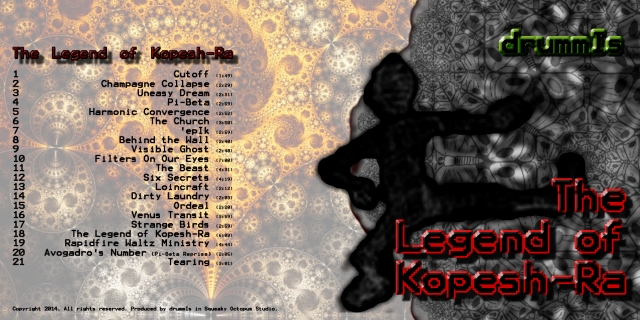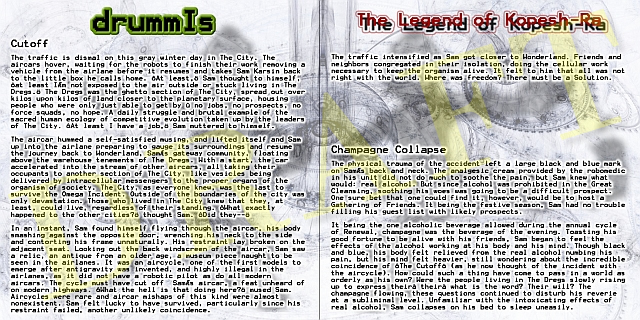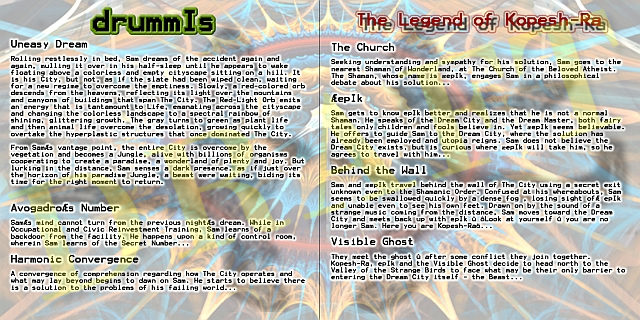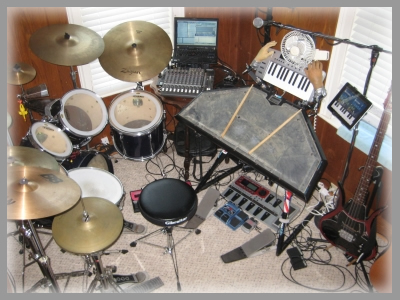for downloadable music, visit drummIs.bandcamp.com
|
|
|||
Coming soon...
The Legend of Kopesh-Ra
A Story in Twenty-One Musical Chapters
Samples:
Track 2: Champagne Collapse
Track 4: Pi-Beta
Track 9: Visible Ghost
Track17: Strange Birds



more to come...
The making of...
The Legend of Kopesh-Ra was made from gathering what I felt was the best of a collection of songs performed over the past two years. My method of composition is improvisational -- I literally don't know what I'm going to play when I start, and I use a loop machine to develop depth and breadth of sound. So, I may start with a drum beat, add some guitar chords, throw in a bass line, then use a lead sound from the iPad (I like the vibes, tanpura, flute, sax , electric piano, and various synths best) or the guitar to solo over the loop (this is why many of the songs have a repetetive sound, while the interest and variety are kept in the lead). All of the music is instrumental, as I have absolutely no ability to come up with lyrics on the spot or otherwise, nor any particular singing skills. Much of the improv (typically more than half) is edited out, particularly the opening looping sequences and a lot of the garbage I end up playing during the solos. But there are a few parts that typically sound decent, so I add effects and compress them using audio editing software and then upload the pieces to my Bandcamp site.
From the sixty or so songs I developed this way over the past two years, I culled twenty-one songs (originally twenty-three, but I cut two from the album during editing) that I felt represented a good sample of my work. The resulting twenty-one songs were then re-edited and mastered, and put in an "album order" (old concept!) that seemed desirable. But something was missing -- twenty-ish disconnected songs, other than some similar instrumentation, with nothing to tie them together? I hesitated to add any kind of vocals to the already recorded tracks, as I thought that would seem both artificial and would highlight my lyric-writing deficits and my sketchy vocal talents a little too much (the only time my real voice appears in the recording is a brief "hey" near the opening of the song "Avogadro's Number").
So, I decided to go with a story concept, a short narrative to accompany each song, developing the narrative as I relistened to the song to allow the emotion and sensibility of each unique piece of music to inspire the writing process. The song titles were also part of what lead me into a coherent narrative (most song titles had been chosen months ago on the fly after recording the improv sessions, sometimes inexplicably, as with "Loincraft," a nonsense word that just popped into my mind as I sat in front of the dialog box on my screen, cursor blinking). Not long after the writing progressed, I started weaving together a tale given to me by the Muse, but directed by my anthropological interest in mythology and my sociological interests in post-apocalypticism and social renewal. These themes become apparent in this myth-cycle story of an individual initially defeated by his society, but who, through a fantastical journey, ultimately becomes the source of its reformation. Much of the imagery derived from many of the popular (and unpopular) science-fiction and fantasy films and books I've seen and read.
The final product, after much editing of music and story alike, turned out to be an interesting instrumental concept-album that I hope you will like. Each "chapter" is less than a page long and can easily be read as the songs are listened to. While metaphorical, I found the story compelling to write and it took on a life of its own as I sat down each night to figure out what the music was telling me as I typed. I hope that the musical influence on the story-writing creates a combined "feel" for the story and music together and provides a more powerful way to listen and think about the language of music and the music that is language.
- drummIs
![]() Thanks GNB!
Thanks GNB! ![]() T
T
drummIs is an improvisational electronic looping musician. The confluence of technology and art is a real fascination, particularly given processing power which allows for better reproduction of sound imagery, and in terms of speed and recordability which allow for the real spirit of a session to be captured, rather than relying on prerecorded riffs and samples to define the space of the music.
 drummIs
started playing the drums about 40 years ago, when he was setting up coasters on the coffee table and banging
on them with pencils. Not long after, his fortunate parents acquired for him
a nice used Ludwig drum kit and the rest was history. He has played in over ten different
cover and original bands, with one of the more recent projects producing a CD
recording and touring briefly (see
below). In addition to drums, he has recently taken up the guitar and iPad as instruments in order
to understand better the range and breadth of the musical experience.
drummIs
started playing the drums about 40 years ago, when he was setting up coasters on the coffee table and banging
on them with pencils. Not long after, his fortunate parents acquired for him
a nice used Ludwig drum kit and the rest was history. He has played in over ten different
cover and original bands, with one of the more recent projects producing a CD
recording and touring briefly (see
below). In addition to drums, he has recently taken up the guitar and iPad as instruments in order
to understand better the range and breadth of the musical experience.
drummIs works with hand drums, guitars, miscellaneous percussion, the trapKAT, a Roland TD-5 drum brain, the RC-50 Loop pedal, Boss GT10-B effects unit, a Digitech Bass compressor, Behringer Multi-Effects pedal, a Mackie 1402VLZ mixer, Propellerhed's Reason Adapted, Ableton Live, Shure SM58 microphones, and a squeaky octopus.
drummIs produces his music in a home studio (right), as well as performing in local establishments and live in the virtual world of Second Life with his California-based brother "Jackson Xaron," making a coast-to-coast music venture possible through the magic of the Internet. Online they are known as "The Dreadful Gate" (website forthcoming) and perform Tuesdays bi-weekly on the DarkStar island in Second Life.
When not playing music, drummIs is better known as Professor Kurt Reymers, an associate professor of sociology at Morrisville State College (State University of New York). He resides in a lovely small hamlet nestled away in the charming Shire-like countryside of central New York.
These samples would likely be categorized in the ambient/electronica category. My early experimentation with midi composition and production utilizes the trapKAT, Roland TD-5, Sound Blaster FM synth, and various sampled wav clips. Lately, I've incorporated the RC-50 three track looper and several effects pedals, while also taking up the guitar and keyboards to add texture to the compositions. This is demo material only, with no mastering involved.
2012-2013: Current original |
Other original music featuring drummIs:
2011: drummIs performs with The Electric Golem and
Roy "Futureman" Wooten (of Bela Fleck and the Flecktones)
Self described as "pop-progressive," the music is reminiscent of early prog rock, with a contemporary edge. This foursome, together from 1993-1999, consisted of keyboards (Mark Frey), guitars (Mike Criscione currently with Buffalo-based alternative band Ultraviolet), bass (Ken Devlin, currently with the Buffalo-based industrial band Garda), and me, drummIs (aka Kurttis Blaze), on the electronic drums (trapKAT, Roland TD-5 & TD-7) and other miscellaneous percussion. The composition was largely initiated by Mark or Mike, with the band filling in important changes and fleshing out the sound in rehearsals.
Riley found success in the Buffalo area, while also playing in the nearby cities of Rochester, Pittsburgh and Cleveland. Their technique-intensive live shows, regional radio airplay, and high profile performances (a 1999 season opening slot at Buffalo's "Thursday at the Square" concert series) propelled them to be voted Best Original Rock band at the 1999 Buffalo Music Awards. Riley produced one CD, "Blueprint", engineered and produced by Mike and Mark in our basement studio (Squeaky Animals Productions), mastered at Metalworks Studios by producer Nick Blagona (Nazareth, Deep Purple).
I did most of the midi drum editing for this recording, sang some background vocals (Lorelei), and wrote the lyrics to "Going to Work," a song that didn't make the cut for our first disc, but was scheduled for the second disc that was never produced. The band broke up in December 1999.
Unauthorized reproduction is unlawful. Violators will be vigourously hosed down and then prosecuted.

Blueprint
| Title
|
Download |
| 01 This Song | |
| 02 Caroline's Father | |
| 03 Hadrian's Wall | |
| 04 Psychopath | |
| 05 Lorelei | |
| 06 Road's Taken | |
| 07 Something Different | |
| 08 State of Mind | |
| 09 Ice Song | |
| 10 Stinging In My Eye | |
| 11 Forget | |
| 12 River of Memory | |
| 13 Undone | |
| 14 Epiphany |
Unreleased Material:
Title
|
Download |
| Going to Work | |
| Chandrasekhar's Limit (live) | |
| Wonder
Woman (appeared on Buffalo, NY's 103.3 The Edge TV Theme CD) |
|
| Vertigo | |
| Undone (live) | |
| Hero's Welcome | |
| Magic Fingers - Live (Frank Zappa cover) |
Riley Reunion, Nov 2008
A straight ahead rock threesome consisting of guitar (Mike Criscione), bass (Brian O'Connell, formerly in well-received Boston jam band Uncle Sammy, also with the Gordon Stone Band), and yours truly on electronic drums (trapKAT/Roland TD-5 combination). These recordings were made in a brief session one day at Outer Limits Studio, near Buffalo, NY (thanks to Ken Rutkowski for engineering), but were never mastered or released.
(Note for pop-up stoppers: hold down CTRL to allow the mp3 samples to open in a new window)
Unauthorized reproduction is unlawful. Violators will be unrepentantly scolded and then prosecuted.
| Title | Download |
| Shy Ann | |
| Riding a Bus | |
| 10,000 Croutons | |
| Reality Check | |
| Phantom Pain | |
| Diamond Lane |
older original music featuring drummIs:
older originals (1996-2001) |
|
|
Title |
Download |
| Bill Meldrum (long version) | |
| Robot Emotion | |
| Remember | |
| Jelly | |
| Jiggy With I.T. | |
| Ganja Trance | |
| Sexy Sushi | |
| Gunga Din | |
| Scot Evil | |
| Totanality
(a drum solo) |
|
| Belarus | |
drummIs's electronic drumkit, the trapKAT, is a device made of a marblized rubber-like surface composed of 24 separate pads (10 on the flat surface and 14 pads around the edges, rim pads), beneath which lie small piezo triggers that alert a separate drum "brain" to play a pre-programmed sound.
Each pad has an electronic sensor laying beneath it which records the strength [velocity] of each hit on the given pad. Thus, each pad is individually programmable in several ways. First, the dynamic range is changable, so that you can alter the electronic sensor of that pad to your individual style of playing (e.g., jazz players are generally easier on their drums than heavy metal players). Second, you can change the individual sound that the pad reproduces when it is struck. These sounds are patched in from a separate drum machine(s) ["brain(s)"] through a MIDI cable (more info on MIDI here). So, pad 1 can be the hi-hat, pad 2 the snare, pad 3 the rim shot, etc. on up to pad 24. There are also two pedals, one for the bass drum and one for a "continuous controller," which is needed to reproduce the opening and closing of a hi-hat.
These pedals, however, are not restricted to these sounds. This provides for a pretty large drum kit. But wait - there's more! There are 24 different variations (of the 24 pad sounds) that can be programmed into the trapKAT. This provides for 24 different pretty large drum kits! Cool. Now, more numbers: the "brains" that I have [Roland TD-5 and TD-7] contain over 600 sound samples - you name it, everything from snare drums to timpani to marimba to guitar chords, latin percussion, electronic f/x, orchestral hits, gongs and whistles. I can choose from any of these to program any given pad. Now you're getting the picture.
The pros and the cons of trapKATing
TrapKATing is fun, no doubt about it. But it has its downfalls too. One great thing I'm sure you've noticed is the cleanness of the sound - it's essentially like putting on a CD of drums and playing it through really loud speakers - except that the sound is spontaneous, not pre-writ. There is no sound "degradation" involved as occurs when you put a microphone in front of an acoustic drum or cymbal and try to squeeze the "natural " sound through that device. Another benefit is the ease of play: with real drums you've really gotta move around the kit, by virtue of it's largeness. It's great exercise, no doubt, but with the trapKAT, you can play patterns and fills more easily because the pads are so much closer, relative to its acoustic counterpart.
However, the trapKAT is not perfect. While the sound samples in the Roland brains are pretty good, they essentially reproduce the same exact sound wave every time you play the same sound. The great variation in the number of drums (e.g. 50 different snare offerings) and the pitch of the drum and its loudness (dynamics=velocity of stick stroke) help to counteract this effect, but the sound wave produced with Snare Drum #32, for example, will always be the same. On an acoustic drum, the variability of sounds, depending on where and how hard you strike the head, changes infinitely. The next -gen Roland drum machine, the V-Drum, changes the sound wave under these conditions, but it will be a long time before a digital sample can approach the near-infinite variety of a real drum. Nonetheless, I think artistic vision is not necessarily hampered by the electronic interface of the trapKAT, as this review suggests:
"A really cool thing about this band [Riley] is how they choose to perform live. [drummIs] performs drums and percussion on an electronic drum pad. Current technology guarantees quality sound production, or sampled re-production, as the case may be. What is astounding to me is the skill and finesse with which the pads are played. Dynamics and style are not the least bit hampered, and some of the artistic fills that this musician accomplishes are mesmerizing. A fine accomplishment that transformed perfectly for the CD production. Masterful!" - Michael Hake, Artvoice (Buffalo's premier arts magazine), July 7, 1998
Also, when the electronics go bust and just stop working, nothing can be done. Gig over, go home. Because I have two drum machines, I have been able to avoid that complete catastrophe, but at one gig we played recently, the TD-5 pooped out, which caused significant hassle and strain for me. Having trained on acoustic drums for 20 years, I absolutely hate this dependency on electronic technology.
There's no doubt that the trapKAT is a different drumming instrument than a standard acoustic kit. To me this offers a challenge to play musically and artistically. At this point I'd like to respond to a critical remark regarding the trapKAT:
"My only production complaint is Kurt’s use of electronic drums, he’s a great drummer technically, but you just can’t replace the sound and feel you get from using acoustic drums and I think that this tames Riley’s sound too much especially when they play live shows but, also on their recording. When you have a musical rhythm section that helps control dynamics, you don’t see the guitarists and solo instruments struggling as much with performances. I know this first hand, trying to pull intensity out of something that just isn’t is extremely exhausting not only for the band but also for the listener." - Leah Pinnevaia, Things to Do, Places to Go, People to See. July 17-30, 1998 Vol. 1, No. 3 Page 13 by Leah Pinnavaia, editor.
First of all, thanks, Leah, for the compliment on my drumming! I appreciate it. But I must disagree on the points of dynamics and intensity that can be reached with the KAT: dynamics can be controlled quite effectively with the trapKAT, as I have mentioned. It has taken me some time to learn the ways of this new animal, but I believe I have met this challenge of dynamic control. For example, one song that demonstrates this I believe is Undone (track 13 on Blueprint). As far as intensity goes, well, no, I don't sweat as much now as when I played acoustics, but I have certainly achieved that level of euphoria that is reached when the intensity is high and the sound is blending into a mosh of four musicians communicating at a level that is higher than everyday consciousness. This is the ultimate goal of artistry, and it doesn't happen at every gig, regardless of the technology one is using, but I do know that it can and does happen with the KAT - this is the challenge of playing in a band, to reach that higher level with your collective music. As much as the trapKAT digitalizes and compartamentalizes the drums, it offers other challenges and opportunities for being artistic, and I will continue to face these challenges and strive to capture these creative opportunities for not only my own pleasure, nor only for the pleasure of my band mates, but for all who listen to the music. After all, that's what it's all about - the music, baby, the music! YEAH!
Thanks for listening!
Come back soon to see what I've been working on.
Contact: kreymers@gmail.com
All material on this website ©1996-2013, various entities.
Permission required for reproduction. Violators will be put into the Total Perspective Vortex then prosecuted..